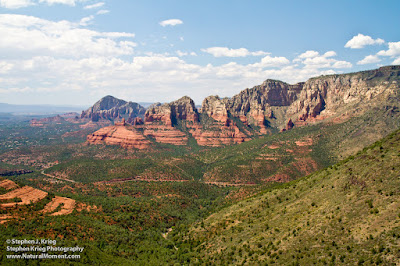 |
| [Photo: Moonrise above the pines. Click on image for larger version.] |
Unless you're using a brightly lit cityscape as the landscape, the best evenings to get great moonrise shots are the night before the full moon, or sometimes even two nights before.
Why? Because on the night of the actual full moon it usually comes up too late to have enough natural light from sunset-time to illuminate the scenery. And, again, for nature landscapes if you wait until the full moon you will merely have a bright round disk in the black sky and nothing else.
The moon rises approximately 40 minutes later each day. Thus it rises about 40 minutes earlier each day, too. So your moonrise scenes the night before (or two nights before) the full moon will have a naturally lit landscape with the moon so close to full that it's hard to tell it's still a day or two shy of full.
But where in the eastern sky will the moon rise this time? It varies by month, through the seasons. It doesn't always rise straight due east. Far from it.
Fortunately there is a free computer app on the Web called The Photographer's Ephemeris (TPE) that takes the guesswork out of it. Go to http://photoephemeris.com/ and install it on your machine. (There is even a smart phone app available for a small fee, for you wild and crazy on the go types).
 Then open that puppy up and type in the location you want to check out. TPE then shows the moonrise/moonset and sunrise/sunset for each day that week. You can jump ahead to any date on the calendar. (The light blue line is where the moon will rise; the dark blue the angle at which it will set). Along with the azimuth (angle in degrees on a compass, if you want to get that accurate).
Then open that puppy up and type in the location you want to check out. TPE then shows the moonrise/moonset and sunrise/sunset for each day that week. You can jump ahead to any date on the calendar. (The light blue line is where the moon will rise; the dark blue the angle at which it will set). Along with the azimuth (angle in degrees on a compass, if you want to get that accurate).Also onscreen (see below) is a Google Map for your location, with colored lines depicting the direction of moonrise/moonset, etc.
But you don't have to be a surveyor to make great use of this tool, and easily. Here is a real world example from earlier this month.
 Let's say that you have a local volcano that you would love to have the moon rise over, so you can zoom in on both and thrill your fans on Google+. (What, you don't live near a volcano? Really? There are many old volcanoes here near Flagstaff, Arizona. So if you want one to photograph, move here.)
Let's say that you have a local volcano that you would love to have the moon rise over, so you can zoom in on both and thrill your fans on Google+. (What, you don't live near a volcano? Really? There are many old volcanoes here near Flagstaff, Arizona. So if you want one to photograph, move here.)Anyway, one of my favorite local volcanoes is on the Coconino National Forest about 12 miles north of town, and there is a big mountain meadow named Bonito Park that has a clear view of this 1,000 foot tall volcano named Sunset Crater almost smack dab to the east. Where the moon will rise, somewhere. Perfect.
 I started with my TPE map set on downtown Flagstaff, to get an idea of the direction in which the moon would rise. Way north of East at this time of the year. Meaning way north of Sunset Crater, like I figured having seen it much the same last month.
I started with my TPE map set on downtown Flagstaff, to get an idea of the direction in which the moon would rise. Way north of East at this time of the year. Meaning way north of Sunset Crater, like I figured having seen it much the same last month.To verify, I zoomed in on the map and moved the red "pin" to where I knew the turnout on the entrance road along Bonito Park is. Yep, looks like the moon will rise well to the north of the stately young (only about 950 years old) volcano.
As you can see from my highly technical in-the-field photo illustration, the moon did rise as predicted, affording no closeup of our beautiful lunar satellite rising over the big cinder cone. Only a wide angle shot, though it was fine enough, considering.
Note that even at dusk like this, you can capture the Earth's shadow on the eastern horizon if you have a clear enough view, and detail in the foreground, etc. If I had waited until the following evening all I would have had was the bright moon in a black sky.
Skipping ahead month by month on TPE's calendar, I see the moon's angle traveling steadily southward, toward due East. In April it looks like it will rise right over the behemoth. Guess where I'll be the night before Full Moon in April. And the night before that, for good measure.
So why don't I merely Photoshop the moon in, over the volcano? That's no fun to me. By studying what's going on, where the moon and sun will be through the seasons, is a large part of the satisfaction.
But that's just me. You do what you want.
You might also be interested in my Grand Canyon Photography blog.













